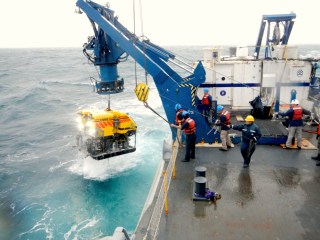The F-16, like this one, was headed from Japan to North America when it went down.
The Navy’s always ready to help out the Air Force – especially when the flyboys are trying to figure out why one of their F-16s went down last summer off the northeastern coast of Japan (the pilot was ok).
Only one problem: the wreckage ended up more than three miles down in Davy Jones’ locker.
Not to fear: the Navy, and its contractor, Phoenix International Holdings of Largo, Md., hunted down waterlogged remnants of the F-16 more than 16,400 feet below sea level in August. Using a side-scanning sonar and an underwater drone, the team was able to bring back what Air Force accident investigators wanted to see.
Getting to the downed craft was no small undertaking. According to the company:
In early August 2012, at the direction of the Naval Sea Systems Command’s Director of Ocean Engineering, Supervisor of Salvage and Diving (SUPSALV), Phoenix mobilized the Navy’s ORION deepwater side scan sonar system, the CURV 21 remotely operated vehicle (ROV), and the Navy’s motion compensated, 30,000 pound Fly-Away Deep Ocean Salvage System (FADOSS). All equipment was transported over land from Phoenix’s facility in Largo, Maryland to Dover Air Force Base in Delaware. From there, military transport aircraft moved the equipment to Hawaii, where the gear was loaded aboard USNS Navajo (T-ATF 169).
After a 10-day transit to the crash site, underwater search operations commenced using the Navy’s 20,000 fsw [feet of seawater] depth search system, ORION. After searching the initial planned search area spanning a 2 x 4 nautical mile (nm) area, search operations shifted to another high-probability area and the suspected F-16 debris field was quickly identified. Next, Phoenix personnel deployed the CURV 21 deepwater ROV system and conducted a detailed video survey of the area in which several high priority items, including the Flight Data Recorder and engine, were identified. Over the next 10 days, the Phoenix team piloted the CURV 21 ROV through 12 dives and recovered all critical items desired by the embarked accident investigating board.
Phoenix spokesman Peter LeHardy says his company has a Navy contract for such work as deep as 20,000 feet. It does the work with Navy gear it maintains and operates. “Recovering the F-16 was well within our capabilities,” he adds. “Our deepest effort to date was a recovery of a subsea sensor back in 2010, at a depth of 18,558 feet.” The Navy said the operation cost it $1.4 million.
LeHardy says he has “no idea” why the Air Force is going to such great depths. “It usually has to do with determining the cause of the crash,” he says. The Air Force never discusses such investigations until they’re finished.
Let’s hope it was worth it.



